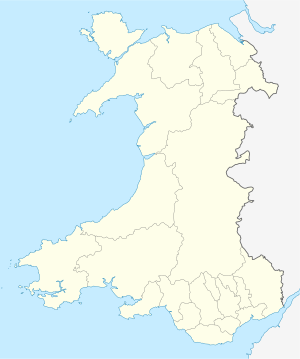Pontcysyllte Aqueduct
Coordinates: 52 ° 58 ′ 13 ″ N , 3 ° 5 ′ 16 ″ W.
| Pontcysyllte Aqueduct | ||
|---|---|---|
| Convicted | Llangollen Canal | |
| Crossing of | River Dee | |
| construction | Trough bridge | |
| overall length | 307 m | |
| width | 3.5 m | |
| Pillar spacing | 16 m | |
| height | 40 m | |
| opening | November 26, 1805 | |
| location | ||
|
|
||
The Pontcysyllte Aqueduct [ ˌpɔntkəsəɬte ] is as navigable Trogbrücke executed aqueduct that the Llangollen Canal over the valley of the River Dee between the municipalities Trevor and Froncysyllte in north-east Wales leads. It was completed in 1805 and has since been both the longest and tallest aqueduct in Britain . It is classified as a "1st class cultural monument" according to British monument protection criteria and has been on the UNESCO World Heritage List since June 2009 .
construction

Built by Thomas Telford and supervised by the experienced canal construction engineer William Jessop , the aqueduct was part of the waterway originally named Ellesmere, now known as the Llangollen Canal , and is one of the most outstanding examples of engineering at the time. The aqueduct is 307 m long, 3.35 m wide and 1.60 m deep. It consists of a cast iron channel that runs 38.5 m above the river, supported by 19 solid bridge piers that are hollowed up from a height of around 21 m (70 ft ). The span is 16 m each. Despite the concerns of many skeptics, Telford was certain that he had already built another cast-iron aqueduct (the Longdon-on-Tern Aqueduct on the Shrewsbury Canal , which is still open to visitors today, although the canal was abandoned years ago) .
The mortar used included lime, water and ox blood. The stones were broken locally. The cast iron was supplied by William Hazledine from his factory in Shrewsbury and nearby Cefn Mawr . The cast iron plates that formed the navigable trough were manufactured in the Plaskynaston foundry and screwed together. Welsh flannel cloth soaked in boiling sugar was used to seal the joints . Finally, the seams were sealed with lead. Finally the trough was filled with water and observed for six months whether water was leaking from the trough.
The opening took place on November 26, 1805 after ten years of planning and construction in the presence of about 8,000 spectators. It ended up costing a total of £ 47,000 . A worker involved in the construction received a weekly wage of 40 to 60 pence.
business
The towpath protrudes on the east side over the channel, which takes up the full width of the aqueduct. The remaining fairway on the west side of the aqueduct is only a few centimeters wider than a narrowboat , the special type of boat for the Central English and Welsh canals. The navigation therefore takes place on sight in one-way operation. The users of the towpath are protected by a railing on the outside of the aqueduct. The existing holes for a possibly planned railing on the other side of the trough have remained unused to this day. That is why there is nothing between the canal trough, which ends just a few centimeters above the surface of the water, and the helmsman of a narrowboat but the prospect of a fall from a height of almost 40 m. After the commercial decline of the canals at the beginning of the 20th century, almost exclusively pleasure boats now use the canal system.
In the middle of the aqueduct is a valve that is opened every several years for maintenance of the trough. The water from the trough then cascades spectacularly into the River Dee. Before this, the aqueduct is blocked off on both sides by installing dam beams across the canal.
literature
- Amy Douglas, Fiona Collins: Memories of Pontcysyllte. Tempus Publishing, Stroud, 2006, ISBN 0-7524-3770-4 .
Web links
- Pontcysyllte Aqueduct. In: Structurae
- Panoramic Views: The waterway in the sky. In: BBC. (English, Java required).
- Plug pulled on historic aqueduct. In: BBC News . January 22, 1998(English, pictures of the aqueduct).
- Pontcysyllte Aqueduct and Canal World Heritage Site. (English).
- Entry on the website of the UNESCO World Heritage Center ( English and French ).
Individual evidence
- ↑ Listed Buildings: Pontcysyllte Aqueduct, Trevor. In: wrexham.gov.uk. Archived from the original on October 13, 2008 ; accessed on November 26, 2020 (English).
- ↑ Aqueduct crowned world wonder. In: British Broadcasting Corporation . June 27, 2009, accessed November 26, 2020 .
- ^ Hugh McKnight: The Shell Book of Inland Waterways. 2nd Edition. David & Charles, Newton Abbot et al. a. 1981, ISBN 0-7153-8239-X , pp. 69f.



